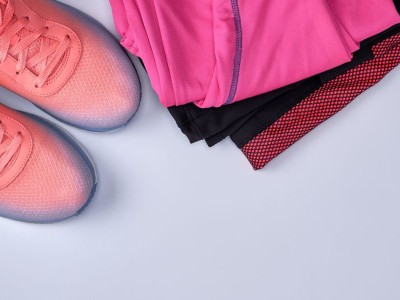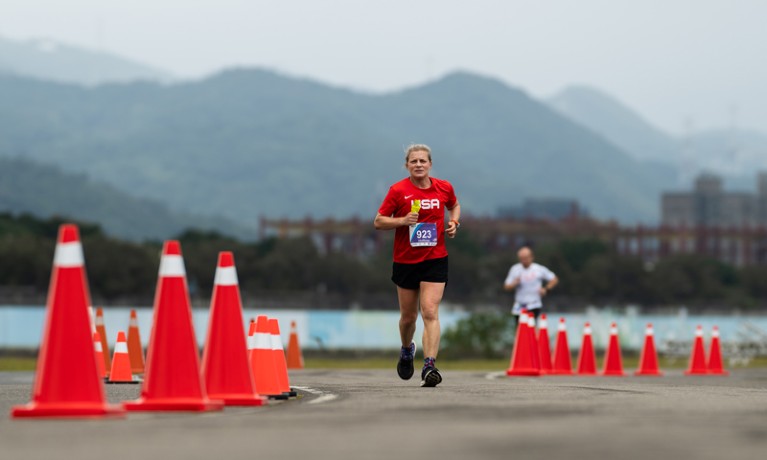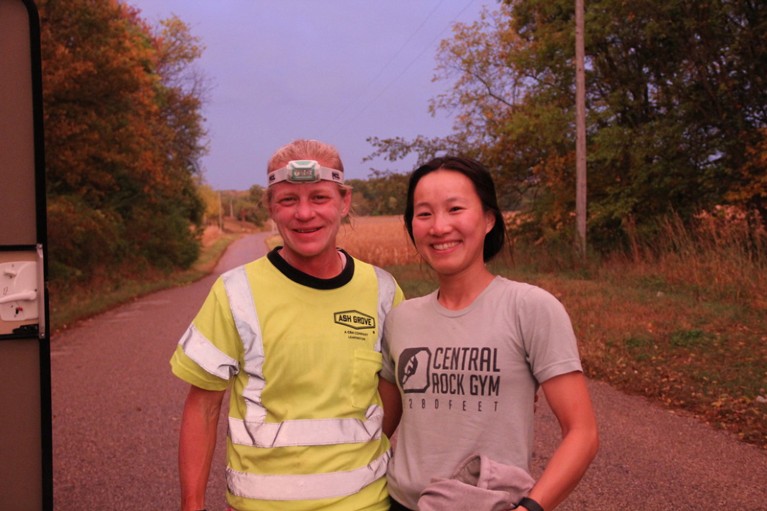
Physicist Jenny Hoffman running the long road through Utah on day 11 of her record-setting journey across the United States.Credit: Jill Yeomans
Jenny Hoffman made a last-minute decision to launch a new attempt to run across the United States, coast to coast, in pursuit of a world record. A physicist at Harvard University who studies the properties of insulators and conductive materials, she turned to the time-honoured method of recruiting willing students to help. In just two weeks, she pulled together an enthusiastic team to accompany her along the route, supplying her with food, water and emotional support.
Hoffman took a sabbatical, left her laboratory in the care of a senior research scientist and set off from San Francisco on 16 September 2023. Her 4,888-kilometre route took her through California, Nevada, Utah, Colorado, Nebraska, Iowa, Illinois, Indiana, Ohio, Pennsylvania, New Jersey and New York. Sleeping in a camper-van that followed her along the way, she averaged more than 100 kilometres per day while navigating narrow-shouldered highways, thunderstorms, dogs and even large pieces of farm equipment that nearly ran her off the road.
A mere 47 days, 12 hours and 35 minutes later, Hoffman arrived at the New York City Hall. For the final few kilometres, she was accompanied by dozens of friends, family members and fans. Her time smashed the previous women’s record by more than a week. She returned to Harvard’s physics department in Cambridge, Massachusetts, victorious. Less than a month later, she flew to Taiwan to compete in the 24H World Championship, an international 24-hour run, in which she was placed 23rd in the world.

Embracing challenge: combining marathon training with graduate studies
Now, Hoffman is back in the lab, writing grant proposals in an office her colleagues had decorated with balloons, and trying to readjust her metabolism after consuming 8,000 calories a day while racing. She’s also trying to decide on her next big goal, which might not be an athletic one. “You can have a scientific impact, but you can also have an impact by being a good mentor or giving somebody the confidence they need to do a hard thing,” she says. “The people impacts are maybe more accessible to me right now.”
Double duty
Many scientists would worry that the intensive training needed to achieve an extreme athletic goal would affect their research output. But Hoffman is no slouch. Her lab has published dozens of papers, including one in Science last March about quantum oscillation in a type of insulator material1. She mentors students in her lab and others, and attends numerous conferences. “I don’t think there’s any compromise in any dimension of her life,” says Daniel Lieberman, an anthropologist at Harvard who studies the evolution of human athleticism and runs with Hoffman every Tuesday morning. “I don’t think she sleeps.”
Hoffman insists that she does sleep — for around seven hours a night — but says that, for her, running is a necessary life function. “It’s just part of the self-care that I that I do every day,” she says. “Even if you have a grant due tomorrow, you’re gonna brush your teeth, right?” Tracking her time and looking for ways to make things more efficient helps, although she concedes that she has no time for a social life beyond her husband and three children.

A few weeks after completing her run across the country, Jenny Hoffman competed for Team USA in the 24H World Championship 24-hour race in Taiwan.Credit: Howie Stern
She does frequently worry that she is neglecting either her career or her athletic pursuits. “There’s this myth of having it all or doing it all and you can’t,” she says. “I’m definitely not as good a physicist as I would be if I were not running, and I’m not as good a runner as if I were full-time. But you only get one life, and I don’t want to throw away either of those activities.”
Running has been a part of Hoffman’s life for more than 30 years, although she only started pursuing it seriously in 2014, after her third child was born. She never expected to be successful. But she soon found herself winning ultramarathons — races that are 50 km, 100 km and longer — and her objectives became more and more difficult. Her 2023 run across the United States was her third try, following a particularly heartbreaking attempt in 2019, when she injured her knee with only 800 kilometres left to go.
Teamwork makes the dream work
The latest run couldn’t have happened without a lot of teamwork, Hoffman says. During the most intensive two weeks of training, the amount of time she spent in the lab halved, but she trusted her group, comprising around 30 people, to keep the science going. “I’m really lucky that I have a great group of students who work together as a team really well and they’re able to turn to each other for questions and advice,” she says. The team, she says, was used to working without her being physically present as a result of the COVID-19 pandemic, and her senior scientist was able to deputize for her, handling problems.
The training and run itself needed a team, too, which included Hoffman’s husband, as well as massage therapists and a professional logistics coordinator, along with a support team cobbled together from students and old friends. Among them was Yanting Teng, a physics student at Harvard who signed up to drive Hoffman’s support van in Iowa and Illinois. Teng was particularly impressed with Hoffman’s drive to get to her next stopping point each day, and her willingness to push further if she was unhappy with her progress that day. “If she wants to do something and feels good about it, she will go for it,” Teng says. “I’ve never seen anyone so determined.”

Graduate student Yanting Teng (right) helped on Jenny Hoffman’s support crew for part of the journey.Credit: Jill Yeomans
Determination might be the key to being a good ultrarunner — and a good scientist, Hoffman says. “You need to be okay with repetition to be successful in the lab and sometimes you need to repeat a task many times to get it right,” she says. “I think that same kind of mentality applies to running long distances.”
Science itself supports that assessment. Although little research has been done on ultrarunners, Lieberman says that mental stamina and pain tolerance are the most necessary traits, on top of good form and endurance. The human body evolved to run long distances rather than short sprints, he says, but land mammals didn’t evolve to run Hoffman’s average of 101 kilometres a day. “No horse can do what Jenny did,” he says. “You’d kill the horse.”
To Hoffman, running long distances is not only a personal challenge, but also a necessary escape. Many people with demanding careers find that they think most clearly while running or working out, describing it as a chance to clear the mind and think about problems in a new way. But Hoffman says she never thinks about physics while running. Instead, she listens to audiobooks.
In fact, Hoffman says, the objective nature of the sport puts her day job in perspective. “Human judgement plays a huge role in science and much less of a role in running, so I really appreciate being able to do something where somebody else’s opinion doesn’t matter,” she says. “There’s no anonymous peer reviewer. I just run the time I run.”
